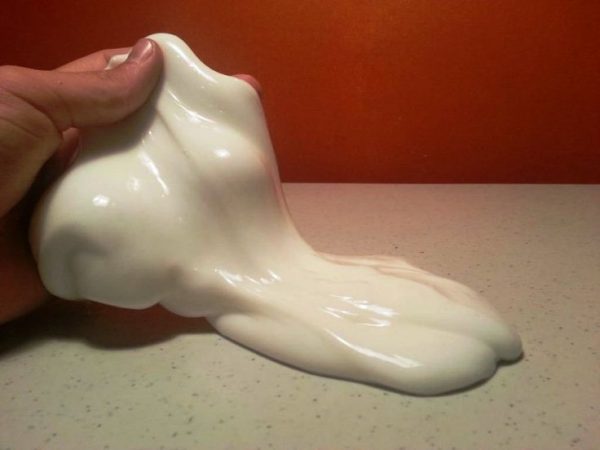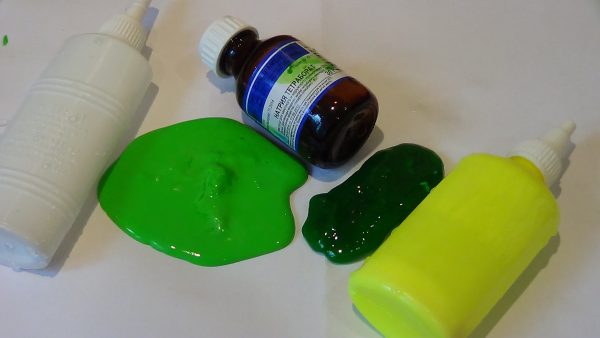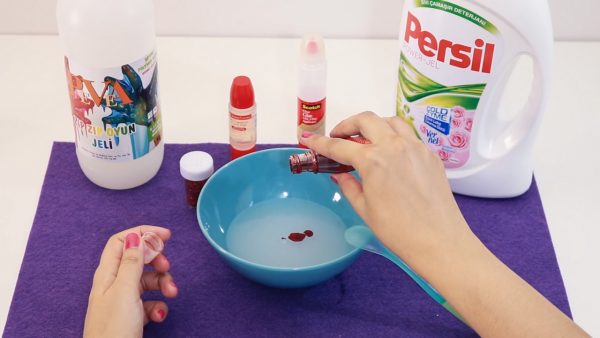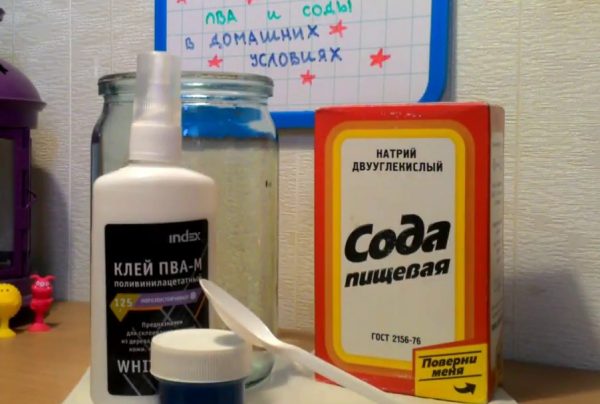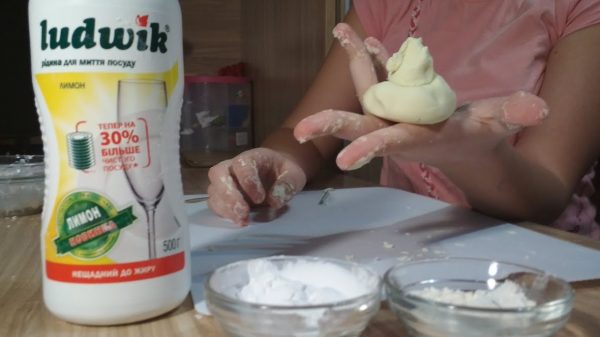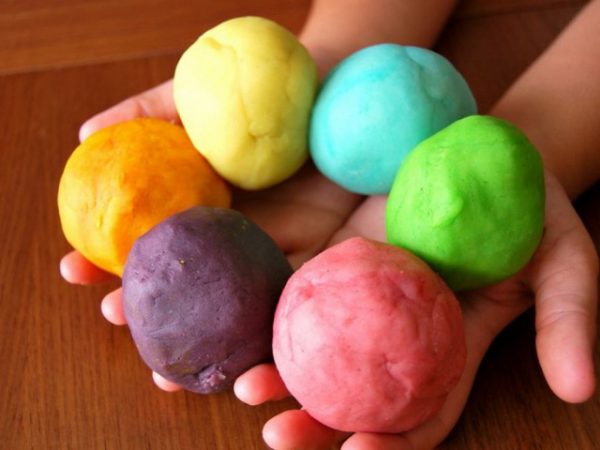Handgum is a modeling material, loved by its properties not only for children, but also for their parents. This toy is also known as “chewing gum for hands” or “smart plasticine”.
- Using glue
- From glue and borax
- From glue and detergent
- From PVA and soda
- No glue: made from corn starch and dishwashing detergent
- Tips & Warnings
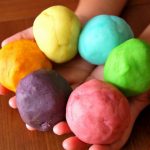
Handgam properties are amazing! This substance can take any form, be plastic, solid and liquid at the same time. Its consistency directly depends on the applied force. If you leave the clay on the surface, then after a few minutes it will begin to spread and turn into a puddle. If the mass is crushed and stretched, it will be a viscous and viscous substance. With a more active impact, the handgam will behave like a solid: with sudden movements it will tear, and when thrown to the floor - jump and spring like a ball. In the scientific field, a polymer with such properties is called a non-Newtonian fluid.
It is not necessary to go to the store in search of this unusual material. With just a few ingredients at hand, you can easily create it yourself at home.
Let's figure out how to make smart plasticine with your own hands and what exactly is needed for this. We will consider four simple recipes using various components. You can choose the most suitable option for yourself and start conducting interesting experiments with your children.
to contents ↑Using glue
The most common basis for creating chewing gum for hands is universal PVA glue or its analogue. Sodium tetraborate, soda, powder or laundry gel can be added to it.
From glue and borax
So, to create smart plasticine according to the first recipe, you will need only a few ingredients:
- a bottle of special glue (you can PVA);
- sodium tetraborate solution (aka borax);
- food coloring / diluted gouache;
- container and mixing paddle;
- package.
This recipe is very popular and easy to execute. To create manual chewing gum using this method, the following steps are required:
- Pour glue into a pre-prepared container.
- If desired, it can be supplemented with a small amount of colorful sparkles or dye and mix thoroughly until a uniform color.
- Sodium tetraborate should be added a little to the resulting mixture, stirring vigorously. The mass will gradually thicken. By increasing the amount of tetraborate added, you can adjust the degree of density and increase the density of the composition. This ingredient is sold in a pharmacy.
- For comfortable mixing, we advise you to fold the mixture into a film or bag and knead it in this way for approximately 5-10 minutes, until it becomes elastic and soft to the touch.
- Chewing gum is ready!
From glue and detergent
We offer another recipe for making handgam with the addition of glue. Essential Ingredients:
- 250 g of glue;
- detergent;
- dye;
- suitable container for mixing.
Getting to the cooking process:
- Pour adhesive into container. For brightness, you can add dye or glitter to it, then mix everything thoroughly.
- Add detergent or any other detergent to the colored glue (approximately 60 ml).
- Stir the mass until a homogeneous gel-like state, then knead it well with your hands.
- Done! You can try playing with the resulting chewing gum for your hands.
From PVA and soda
For the third method, you need to find the following components:
- 125 ml PVA glue;
- 5 tbsp. l baking soda;
- glass bowl (jar / bowl);
- dye.
Handgam cooking steps:
- Pour a jar of PVA-based glue into a bowl.
- Add the dye here and mix.
- Pour soda and mix gently all the ingredients. The result should be a substance that resembles sand dough in its consistency. If the mixture is very liquid, you can add another portion of soda. Then you need to move the mixture into a bag and knead it there to a state of uniformity.
- The modeling mass is ready to use! After the game, be sure to hide it in a sealed plastic container with a lid or zip bag.
No glue: made from corn starch and dishwashing detergent
There is a method of manufacturing a house’s handgam without glue and tetraborate. To do this, take:
- corn starch - 120 g;
- dishwashing detergent - 120 ml;
- dye (optional) - a few drops;
- bowl and spoon for stirring.
Handgam creation process:
- Pour detergent into a bowl.
- The color of the finished material will match the color of the detergent used. But if you want to get a specific shade, it is advisable to find a colorless detergent and add 3-5 drops of dye to it. Here you can pour a little decorative sparkles to create a radiant effect.
- Now you need to add another main component - corn starch. You need to mix the mixture with a spoon, and then start to knead it with your hands. At first, the composition may crumble, but as it mixes it will turn into a gel-like plasticine. As a result, excess liquid may remain in the bowl, this is absolutely normal.
- The stretching chewing gum is ready - you can squeeze it, throw it like a ball or make funny figures out of it. Do not forget to put the resulting mass into a resealable container.
Tips & Warnings
Before embarking on making a handgam, be sure to study our recommendations:
- Any kind of plasticine will harden one way or another after some time of use.
- To increase the lifespan of such a mass, you can keep it in a refrigerator or other cool place.
- Keep the handgum in a tightly closed container or bag with a zip fastener, otherwise it will dry out very quickly and become unusable.
- It is not recommended to mix the ingredients with your hands, since in the initial stages the mixture can adhere strongly. For convenience, it will be advisable to use a spoon, fork or stick (for example, from ice cream).
- If a child performs the preparation of handgam, adult supervision is required.
- It is not recommended to deal with similar plasticine for children under 3 years old.
- Before starting work, cover the table with newspapers or a tablecloth.
- You can experiment with the proportions of the mixed substances to create a thick or, conversely, viscous consistency.
- The more dye you add, the more saturated the color of the handgam will be. As a coloring agent, gouache, acrylic, green paint, artificial or natural food coloring is often used.
- In the process of preparation, the appearance of a small amount of liquid at the bottom of the tank is permissible.
- Keep in mind: some versions of homemade plasticine have to knead and mix much longer than others.
- If you did not succeed in preparing chewing gum for your hands, then the reason is most likely in excessive violation of the proportions. It is possible that the glue or other elements of the composition were not of good quality or damaged due to the expiration date.
Surprise your child with interesting entertainment! The original handgam will give kids the joy of creativity and contribute to the development of perseverance, fine motor skills, imagination. Ready-made "smart" mass does not get dirty, does not stick to fingers, clothes, furniture and other objects.

